Mykonos, Naxos and Paros
Cyclades, Island Hopping
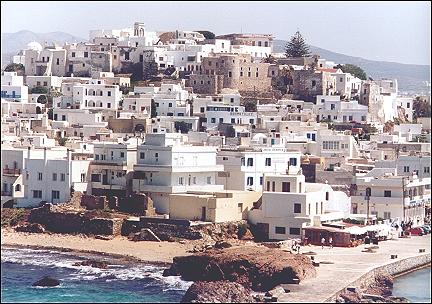
|
The Cyclades islands with their white houses have an enormous appeal. During the summer season they are flooded with tourists. But in May, Naxos with its beautiful capital and spectacular landscapes is still reasonably quiet. On Paros and Mykonos it's already insane. Only early in the morning or when everyone is on the beach you can still discover their charm.
Travelogue & photos: Piet de Geus
Mykonos
The backdrop is dazzling, but we are in the wrong movie
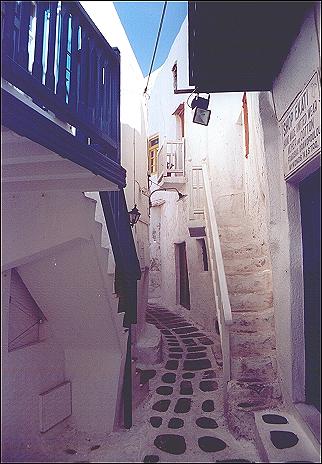 |
The lights of the umptieth island appear on the horizon. When we see five illuminated windmills, it's clear we are approaching today's destination. Around midnight the ferry docks in the port of Mykonos-City.
As usual on the Greek isles, the passengers are greeted by people who want to rent out rooms. A woman makes us a great offer: an apartment in the center of the city, but away from the bars and clubs with their noise. The price is right, too, so we follow her through the maze of narrow streets paved with large, flat stones. The heat of the day still lingers between the houses.
After dropping the luggage in our room we immediately go out into the sultry night. The alleys look wonderful in the lamplight and there are churches and chapels everywhere. The houses have been plastered with white so often that their corners are rounded.
It's busy outside. Not so strange on an island that draws 800,000 visiters every year. We hear music from clubs and bars everywhere.
Mykonos promotes itself as a cosmopolitan island, but the era in which Jacky Onassis and the international jet set visited here, lies far behind us. The trendy gay scene has also found other places to party. Even so the island has, according to the Lonely Planet, "probably still more wannabees per square foot than any other Mediterranean resort". The parade of tanned would-be jetsetters, neo-hippies and not-so-fashionable gay men is funny, though somewhat painful to watch.
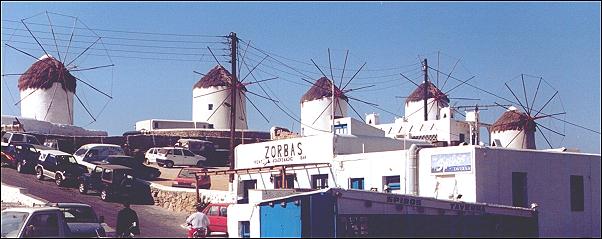
The one thing that never changes on Mykonos is the expensiveness, which bears no relation to the quality of what you buy. We pay 7 euro for a bottle of Corona in a bar. We don't get the time to sit down and drink it, either, because an American latter-day hippie begins to sing Bob Dylan songs. He does it so badly that he wouldn't earn a penny as a street musician. In "worldly" Mykonos-City he gets a gig in a bar...
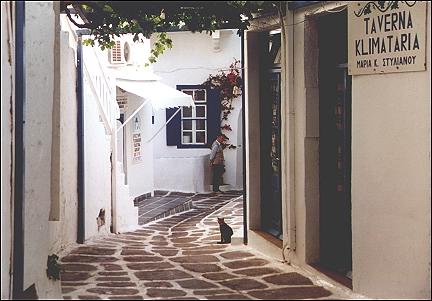 |
What we really want to do is take a tour of the isle of Delos, which was a sanctuary in antiquity. This island lies at the center of the Cyclades, where Apollo and Artemis were born. It has the only large archeological site of the Cyclades.
We would also like a tour of the isle of Aya Anna, where the movie Shirley Valentine was shot on the beach. But alas! in May there only is a ferry to Naxos in the morning, and staying another night on Mykonos would be too costly.
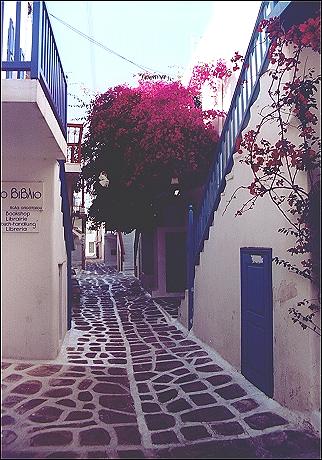 |
We get up early to explore the beautiful alleys in the first light of morning. The shutters and doors of the bright white houses are painted blue, red and green. Here and there the narrow alleys are covered by grapevines. Bougainvillea lights up in the first rays of the sun. Around the fishers port waiters are already trying to lure guests to their terraces.
The area around the famous mills is messy. The taberna next to it is called "Zorba", what else. In Little Venice a row of bright white houses stands with its feet in the surf. Betwen the beach and the fishers port the alleys are even narrower than in the rest of the city. The goal was to confuse pirates, so they would get lost in this maze. It still works. We have to hurry to catch the ferry.
Conclusion after ten hours on Mykonos: the island is a fantastic backdrop, it's a pity that it's for the wrong movie.
Naxos
A beautiful capital and a spectacular landscape
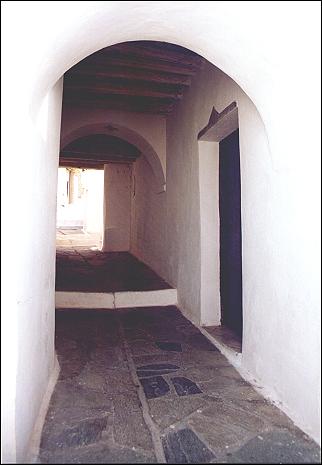 |
The Flying Dolphin leaves a foam trace in its wake as we cross the Aegean Sea. In a little over an hour the catamaran "flies" via Siros and Paros to Naxos, where we are accosted on the quay of Chora (Naxos-City) by a mob with pictures of hotels, rooms and apartments. I hate this. "We have already booked," I lie us through the pushy mob.
A little farther, away from the craziness, a girl approaches us with a very appealing offer: a room in the Bourgos district, just below the kastro (castle). Exactly where we were going to look. Her little brother leads us through a maze of narrow, ascending streets. We push our bicycles along the stalls in the vegetable market. "This looks promising," I grin. We enter through a few more medieval gates, another series of stairs and then we see our terrace, which has a great view of the city and the sea.
Perched on a hill is a 13th century Venetian castle. Parts of its impressive walls and a few gates and towers still exist. The houses inside the castle walls are a little higher than those in the rest of the city, and many doorposts are made of marble. Over the doors are often still the coats of arms of the patricians who lived here, cut into the marble. These streets have many gates and passages.
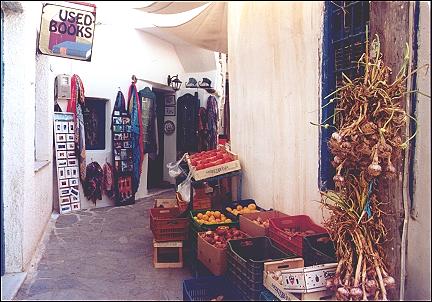 |
When the hottest hour of the day arrives, we seek cooling in the archeological museum. Their collection is very worthwhile: Mycenean and Geometric Era vases, Roman oil lamps, parts of kouros statues and - in the courtyard - a beautiful Hellenistic mosaic.
Really extraordinary is their collection of early Cycladic marble statuettes. It is only surpassed by that in the National Archeological Museum in Athens.
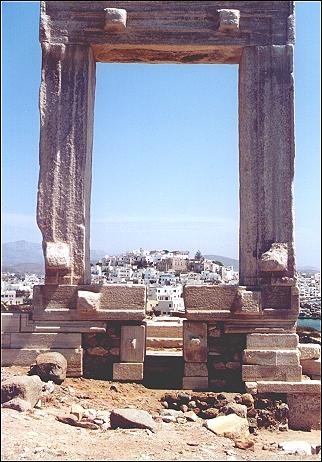 |
We cross the dam to Palatia Island. In the 6th century BC this was the site where an Apollo temple was being constructed. It was never finished but the huge stone gate that was supposed to be the entrance survived and still stands proud. It has become Naxos' logo. From the island we have a good view of Chora.
By 8 PM a stream of people walks to the rocky island. It is more or less a must to watch the sun go down here. The sunset is spectacular indeed: the gate is a black silhouette against a deep-red sky. A catamaran leaves a silver trace in the dark blue water while the golden sun sinks behind the horizon. Immediately afterwards people leave the rock.
We climb up the streets of Bourgos. Near the vegetable market is Manolis Garden, a taberna in a nice walled-in garden. The mezze for two turns out to be a great choice, we get a huge plate of delicious hors d'oeuvres.
Before we bicycle to the highest mountain peaks on the island, we get supplies at the pastry shop Rendezvous on the promenade, which has an enormous selection of excellent pies and cakes. Then we leave Chora via its busy main street.
At first we bicycle along a grey industrial zone, but soon the road is lined with agaves and blossoming cactuses. As we get farther east, the river valley gets narrower and on all sides with are surrounded by mountains with terraces and low walls. Just before Kato Potami the road meanders up an incline. It doesn't matter which way we look, even if we look straight up: there always is at least one little church in our view.
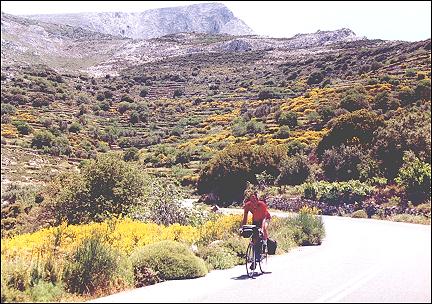 |
The taberna in Mesa Potami is aptly named "Nice View". Its terrace has a view of the valley full of olive trees, vineyards and cypresses. On footpaths which wind between them farmers ride their donkeys.
We climb out of the valley and pass Ano Potami, hidden on a green slope. After a few turns we suddenly bicycle in a wonderful wild area with large rocks overgrown with herbs.
When we reach the fertile Tragea plateau, the surroundings change drastically again: a dozen villages are scattered between olive and citrus plantations. Sand roads and goat paths cut through the small-scale landscape everywhere.
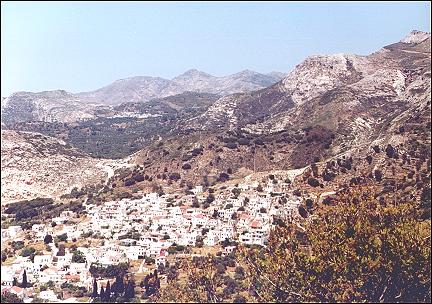 |
At the end of the plateau the road begins to climb to Filotio, a wonderful mountain village on the slopes of Zas, with its 999 meters the highest mountain on Naxos. Old men spend their days in shady outdoor cafés on main street.
When we have passed Filotio the road climbs on a steep slope with terraces. The yellow flowers of common broom are everywhere. There are fields with grapevines. Lizards scuttle away to roadsides full of carnivorous plants with dark purple flowers. The bare peak of Zas rises high above the green-and-yellow wall.
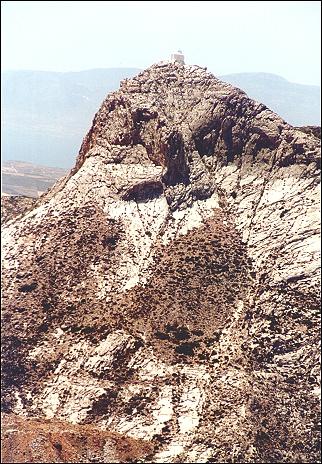 |
A few turns later the road goes north. There is no wind and it's stifling hot in the mountains. Five exhausting kilometers further is a parking lot with a spectacular view of Filotio, deep below us. We can't see the green and yellow slope, but we see bare mountain peaks and in the distance the Tragea plateau. A little white church sits on an impossibly pointed rock on the other side; behind it, in the deep, sparkles the sea.
The road continues winding up for a few hundred meters more. High above us, over the steep slopes, birds of prey, sometimes ten at a time, drift in circles, carried by the up-current. Every now and then, one takes a dive. The running gag of this leg is already: "Let's begin a taberna here and call it 'Nice View'."
At an altitude of 600 meters we pass Apiranthos, a pretty mountain village with two fortified Venetian houses in the shadow of a 798 meters high peak. The road is parallel to the mountain ridge, but it doesn't get any easier. The road is under construction: it's being made wider. For kilometers it is covered with rocks and grit, so we have to walk with our bikes. The view more than compensates for the inconvenience. To our left are mighty mountain peaks, to our right fertile slopes and below them the sea and off the coast a few small islands.
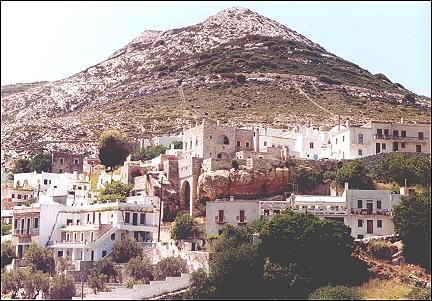 |
On a mountain pass that also is a junction of four roads the road is asphalted again. To the left of the pass water is carried to the west coast, on the right there is a brook that brings the water to the sea, via a wild gorge. On the slope next to the gorge a shepherd walks with his goats, hundreds of meters below us.
The road goes up once more. Half-way our climb a huge herd of goats cross the road. On the 700 meters high peak are many masts, surrounded by dozens of beehives. We see those all over the island.
A few bends in the road farther lies Koronos, below terraces with grapes and built against both walls of the gorge. At one look it's clear why in this area people still use donkeys and mules for transportation. For a long time nearby amaril mines were a source of income for Koronos, but they were abandoned years ago.
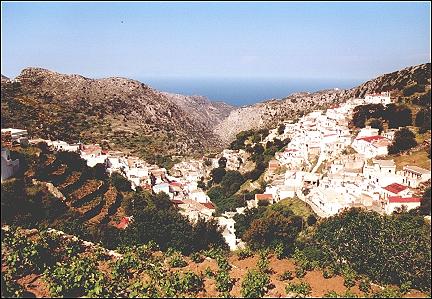 |
The level road winds along Skoda to Koronida. As the crow flies, it's only 4 kilometers to Apollonas. But in that case we would be flying 700 meters above Apollonas.
The dizzying descent has hairpin bends on narrow, bad roads. Soon we see Apollonas, first only as white dots deep below us.
Apollonas is wedged between mountains on a small fertile plane. On its beach lie a few fishing boats and there are some hotels and B-and-Bs. We find a room in five minutes. The only attraction here is a ten meters high kouros (statue of a young man), dating from the 6th century BC. When the marble cracked during the work, the statue was left in the quarry. It is the largest, but the least detailed of Naxos' unfinished kouros statues.
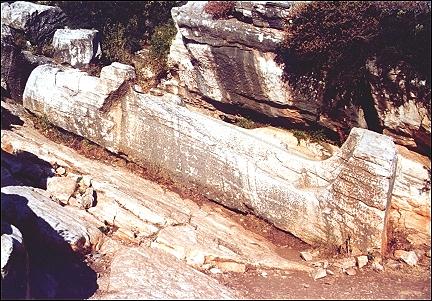 |
The way back to Chora, along the desolate north coast, is less spectacular than yesterday's mountain ride. Still it's a nice route. Apollonas soon disappears in the deep, below terraced slopes, most of which aren't in use any longer.
After we pass the wild north cape the road climbs a little to 300 meters. From there it's up and down over hills above the shore. Deep below us lie deserted bays with water in the most exquisite shades of blue.
A white monastery we pass looks actually more like a fort. Again we see beehives and terraced vineyards. What do you expect on the birth-island of Dionysus. Past an artificial lake we enter a swamp-like delta overgrown with bamboo. Here we pass through the only two villages on this route. Now we only have to pass between two smaller mountains and then we descend to Chora, where our room is waiting for us.
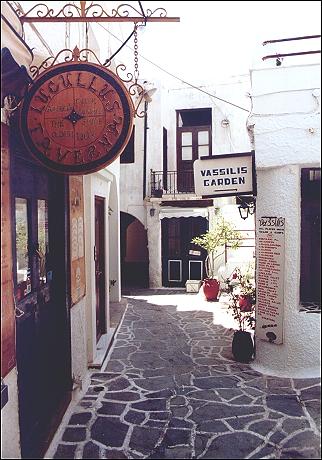 |
We take a last walk through the picturesque alleys with their gates. Late in May, it's remarkably quiet in the most beautiful parts of Chora: Bourgos and Kastro. Many tourists stay in the dull part between the main street and the beach, where most package-tour tourists have their hotels. Only few dare to tread beyond the messy promenade and the first parallel street behind it, where the bad and expensive tourist restaurants are.
Even Old Market Street with its fantastic little squares is quiet. Besides souvenir junk and fake-Cyclades statuettes, you can find beautiful marble statuettes which are hand-made copies of the ones in the archeological museum. One of the best tabernas of the city is on Market Street: Vassilis Garden, since 1951 run by the same family which still cooks all the food.
We take a last look at the illuminated Apollo temple from our terrace. In the distance we see lights on the other Cyclades islands we saw when we were on the coastal road this afternoon. Between them moves a large cruise ship, above them the stars twinkle in the dark sky. Behind us the castle walls are illuminated.
Paros
The ferry hub can't deal with the traffic
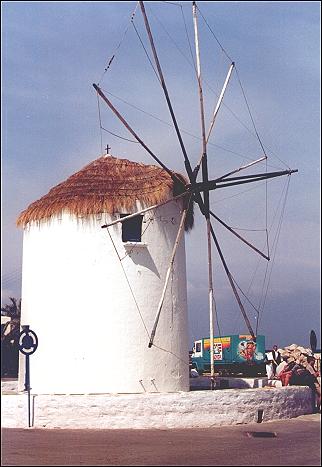 |
The police of Parikia (Paros-City) has its hands full with the rent-a-room mob which again and again threatens to overrun the roundabout at the windmill. Behind the busy traffic, their prey comes walking down the pier, fresh from the ferry that just docked here.
Paros is a ferry hub and the first of the Cyclades islands where most ferries (from Pyreus, the port of Athens) make their first stop. For many, a reason to disembark. Parikia, really only a village, can't deal with that much traffic. Even though Lavidia, the development to the north, has lots of accomodation, and the other side of the large bay is being built up, all accomondation is filled to capacity in July and August. Without a reservation you risk to have to spend the night on the beach. That isn't as romantic as it sounds, because even now, in May, the beach is full of litter.
The coastal road north of the windmill is lined with bad restaurants, souvenir shops and scooter and moped rentals. To the south, beneath the high Venetian walls, there are bars, clubs and outdoor cafés. It's almost as expensive as Mykonos, even though Paros is only comparable to it in busyness.
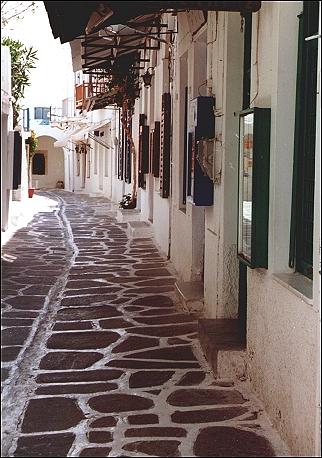 |
Still Parikia must have been a nice village. There are two moments in the day when you can still experience a little of that: very early in the morning and at the hottest time of the day, when the tourists are on the beach and the shopkeepers in the center move their racks with knicknacks inside and take a siesta. Then it's wonderful to wander through the streets.
On a large, triangular square is one of the oldest Greek churches, next to a park. Actually they are three churches, with a monastary in front of them. From the square you see the white monastery and a portal with arcades. When you walk around it, you see the characteristic, staggered roofs of Byzantine churches.
Old Market Street defies the cliché that all houses on the Cyclades are white and blue: it's as if each house has doors and shutters in a different color. Every now and then there's a nice gate and in three places there are 18th century fountains built against the walls. Some of the restaurants are located in majestic Venetian villas.
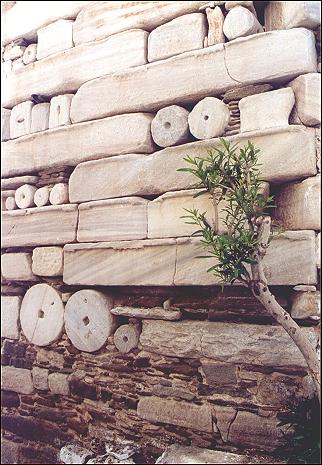 |
Around Old Market Street are pretty alleys with churches and chapels amidst orange trees, bougainvillea and countless potted plants. The Venetians used stones from the ancient temples of Demeter and Apollo to build the east wall of their kastro, of which only a tiny corner remains. Even the columns were used.
From the ferry Paros landscape looked promising, although less spectacular than Naxos. When we bicycle up the slopes of Mt. Ilian, with its 706 meters the only mountain on Paros, we look over waving planes with grapes and wheat.
There are marble quarries that were already in use in antiquity at Marathio. It's fun to know that both the marble for Milo's Venus and for Napoleon's tomb was won here. Other than that, the site isn't very interesting.
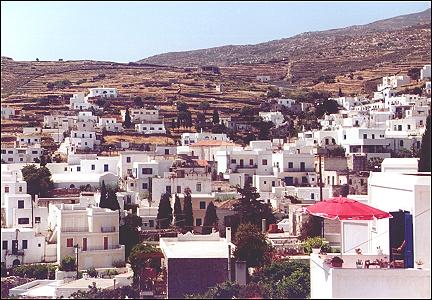 |
The road winds farhter up to Lefkes, a pretty village that lies like an amphitheater on terraced hills. Hikers can take a paved Byzantine path to Prodromos from the village's central square. We descend on an asphalted road and turn left to ride north on a mostly level road.
Via a hill we arrive at a large bay on the north coast of Paros. We have to find our way between the quickly growing hotel and apartment complexes but we follow the descending road en eventually end up in the narrow alleys with white houses of the picturesque fishers village that Naousa was not so long ago.
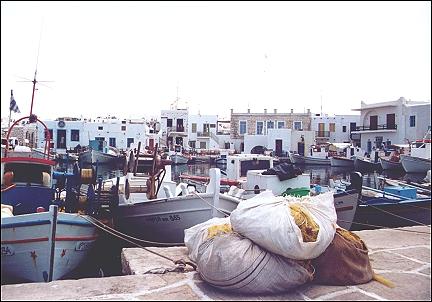 |
It's picture perfect: a beautiful port with colorful fishing boats. On the quays stacks of yellow netting. On a pier are the remains of a Venetian fort and a pretty white church.
Of course the port is surrounded by tabernas and outdoor cafés with rickety wooden tables and chairs. Plastic chairs are not allowed in this environment.
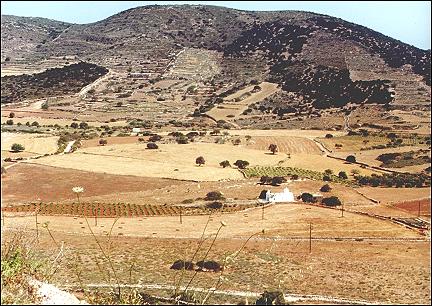 |
The way back leads along waving fields of wheat, with between them, on every high-lying spot, the ubiquitous monastery, church of chapel. The landscape reminds of Tuscany.
Back in Parikia we find to our amazement a restaurant with a good kitchen: Nissiotissa, in a street behind the hospital, run by friendly Turks who take the guests to the kitchen to show what's on the menu. After dessert it's time to go to the port and take the ferry to Samos. We are island hopping, after all.